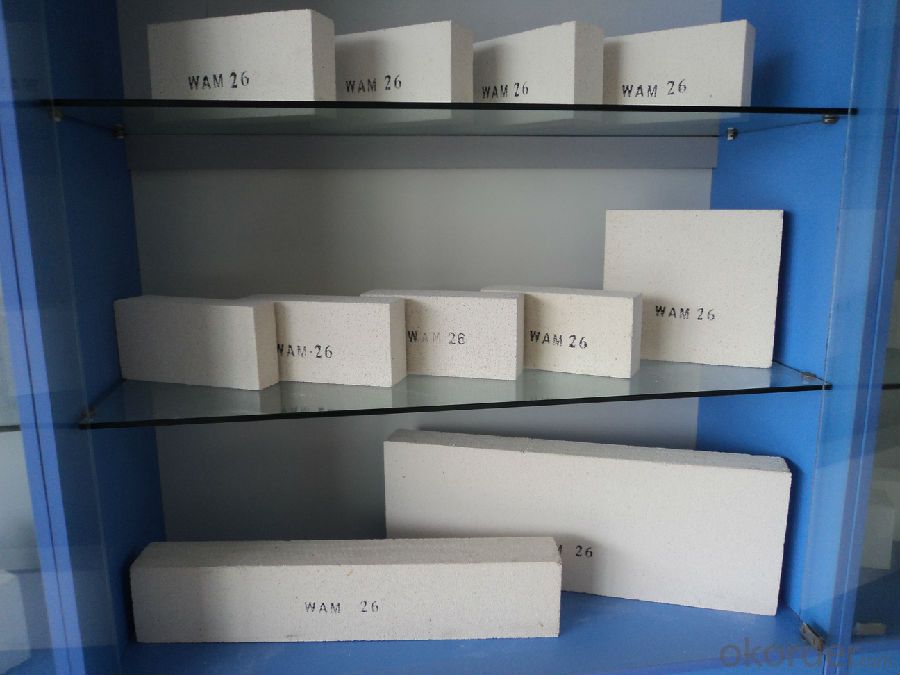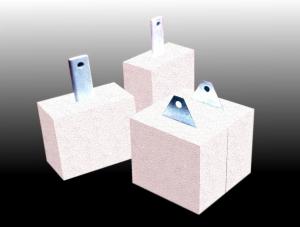Refrctory and Insulating Fire Brick GJM Series
- Loading Port:
- Shanghai
- Payment Terms:
- TT OR LC
- Min Order Qty:
- 17 m.t.
- Supply Capability:
- 10000 m.t./month
OKorder Service Pledge
OKorder Financial Service
You Might Also Like
General Information
CMAX insulating firebricks are classified under temperature between 1300℃ to 1700℃, manufactured from high purity alumina clay.
1. Lower content of iron, alkaline and impurities, good high temperature properties.
2. Homogeneous structure, light weight, energy saving because lower heat storage in the furnace during cooling cycles.
3. High strength, good thermal shock resistance under high temperature.
4. Precise sizes due to grinding and shaping after sintering, which meets the requirement of construction.
5. Max service temp: Up to 1730C (3160F)
Feature
Light weight and low thermal conductivity
Low heat storage
Low iron and impurities
High thermal shock resistance
Application
CMAX insulating firebricks can be used as a hot face lining directly exposed to the heat or as a backup insulation layer in iron and steel mills, non-ferrous foundries, petrochemical, ceramic, glass.
ITEM | GJM30 | GJM28 | GJM26 | GJM23 |
Classification Temperature, ℉/℃ | 3000/1650 | 2800/1540 | 2600/1430 | 2300/1260 |
Bulk Density,g/cm³ | ≤1.0 | ≤0.9 | ≤0.8 | ≥0.5 |
Reheating Linear Change, % | ≤0.9 (1550℃,12 h) | ≤0.8 (1510℃,12 h) | ≤0.7 (1410℃,12 h) | ≤0.5 (1230℃,12 h) |
Al2O3 Content, % | ≥75 | ≥65 | ≥55 | ≥45 |
Fe2O3 Content, % | ≤0.5 | ≤0.6 | ≤0.7 | ≤1.0 |
Thermal Conductivity: | ||||
800℃, w/m.k | ≤0.39 | ≤0.37 | ≤0.35 | ≤0.18 |
1000℃, w/m.k | ≤0.43 | ≤0.41 | ≤0.39 | ≤0.20 |
1200℃, w/m.k | ≤0.48 | ≤0.46 | ≤0.43 | --- |

- Q:Are insulating fire bricks resistant to nitrogen oxides?
- Insulating fire bricks are renowned for their exceptional thermal insulation properties and are commonly utilized in high-temperature applications, such as furnaces, kilns, and industrial boilers. Despite their remarkable heat resistance and ability to endure extreme temperatures, their resistance to nitrogen oxides (NOx) can vary based on the bricks' specific composition and manufacturing process. Nitrogen oxides encompass a group of harmful gases generated during combustion processes, particularly at elevated temperatures. These gases can have adverse effects on both human health and the environment. Even though insulating fire bricks possess a high melting point and can endure intense heat, they may not provide adequate resistance to nitrogen oxides independently. To enhance the resistance of insulating fire bricks against nitrogen oxides, additional measures and coatings may be necessary. These measures could involve the application of specialized refractory coatings or the inclusion of specific additives during the manufacturing process to create bricks that are more chemically resistant. It is essential to acknowledge that the resistance of insulating fire bricks to nitrogen oxides may also depend on the specific application and operating conditions. Different types of nitrogen oxides, such as nitrogen dioxide (NO2) or nitric oxide (NO), may have varying effects on the bricks. Therefore, it is advisable to consult the manufacturer or a refractory materials specialist to determine the suitability of insulating fire bricks in a particular environment where the presence of nitrogen oxides is of concern.
- Q:Are insulating fire bricks resistant to spalling?
- Yes, insulating fire bricks are resistant to spalling. Insulating fire bricks are specifically designed to withstand high temperatures and thermal shock, making them highly resistant to spalling. Spalling refers to the cracking and breaking of bricks due to exposure to extreme heat. Insulating fire bricks are made from high-quality refractory materials that have a low thermal conductivity, which helps to reduce the transfer of heat and minimize the risk of spalling. Additionally, insulating fire bricks have a high melting point, which makes them ideal for applications that involve high temperatures. Therefore, insulating fire bricks are commonly used in furnaces, kilns, and other high-temperature environments where spalling is a concern.
- Q:Can insulating fire bricks be used in the construction of glassware production furnaces?
- Yes, insulating fire bricks can be used in the construction of glassware production furnaces. These bricks have excellent thermal insulation properties and can withstand high temperatures, making them ideal for creating a well-insulated and efficient furnace for glass production.
- Q:Can insulating fire bricks be used in carbon black reactors?
- Yes, insulating fire bricks can be used in carbon black reactors. Insulating fire bricks are designed to withstand high temperatures and provide excellent thermal insulation. In carbon black reactors, which typically operate at very high temperatures, insulating fire bricks can help to reduce heat loss and improve energy efficiency. Additionally, the insulating properties of these bricks can help to maintain a more stable temperature within the reactor, which is crucial for the carbon black production process. Therefore, using insulating fire bricks in carbon black reactors can be a beneficial choice in terms of both thermal insulation and energy conservation.
- Q:Can insulating fire bricks be used in high-temperature insulation for aerospace applications?
- Yes, insulating fire bricks can be used in high-temperature insulation for aerospace applications. Insulating fire bricks are made from lightweight refractory materials that have high insulating properties and can withstand extreme temperatures. These bricks have low thermal conductivity, which allows them to effectively reduce heat transfer and maintain the desired temperature inside aerospace components. Aerospace applications often involve high-temperature environments, such as in rocket engines, exhaust systems, and thermal protection systems. Insulating fire bricks can be used in these applications to provide thermal insulation, protecting sensitive components from excessive heat and preventing heat loss to the surroundings. Additionally, insulating fire bricks are known for their excellent resistance to thermal shock, meaning they can withstand rapid temperature changes without cracking or degrading. This property is crucial in aerospace applications where components are subjected to extreme temperature variations during launch, re-entry, or other operational phases. Moreover, insulating fire bricks have lightweight properties, which can be advantageous in aerospace applications where weight reduction is critical for fuel efficiency and overall performance. By using insulating fire bricks, aerospace engineers can achieve effective thermal insulation while minimizing the added weight to the system. Overall, insulating fire bricks offer a viable solution for high-temperature insulation in aerospace applications. Their high insulating properties, resistance to thermal shock, and lightweight nature make them suitable for protecting critical aerospace components in extreme temperature environments.
- Q:Are insulating fire bricks resistant to hydrofluoric acid?
- Yes, insulating fire bricks are resistant to hydrofluoric acid.
- Q:How do insulating fire bricks help reduce heat loss through convection?
- Insulating fire bricks are specifically designed to minimize heat loss through convection. They achieve this by creating a barrier that prevents the movement of air and heat transfer. These bricks are made from lightweight refractory materials, which have low thermal conductivity. This means that they are not good conductors of heat and do not allow heat to easily pass through them. When these bricks are used in construction, they create a layer of insulation that effectively reduces heat transfer by convection. Convection is the process of heat transfer through the movement of air or fluid particles. The insulating fire bricks act as a barrier, preventing the free flow of air and interrupting the convective currents. The bricks are designed with small, interconnected air pockets or pores, which trap air inside them. These air pockets act as insulators and minimize the transfer of heat by convection. The trapped air forms a stagnant layer, reducing the movement of air and preventing the heat from escaping or entering the area. By reducing heat loss through convection, insulating fire bricks help to maintain a stable and comfortable temperature within a structure. They are commonly used in applications where heat insulation is essential, such as in industrial furnaces, kilns, and fireplaces. These bricks not only enhance energy efficiency by reducing heat loss but also contribute to fire safety by preventing the spread of heat to adjacent areas.
- Q:What is the exterior wall insulation material made of graphite?
- Graphite polystyrene (SEPS) containing graphite particles special, can be like a mirror which contains thermal radiation, and can greatly enhance the heat insulation performance of the infrared absorption, thereby reducing the heat loss of housing. Its insulation capacity is at least 30% higher than the average EPS, helping to increase energy efficiency and reduce carbon dioxide emissions.
- Q:Are insulating fire bricks resistant to high-velocity gases?
- Yes, insulating fire bricks are resistant to high-velocity gases. These bricks are specifically designed to withstand extreme temperatures and are often used in applications where high-velocity gases are present, such as in furnaces and kilns. Their dense and non-porous structure helps to prevent gas penetration, making them an ideal choice for insulation in such environments.
- Q:Can insulating fire bricks be used in refractory linings for blast furnaces?
- Yes, insulating fire bricks can be used in refractory linings for blast furnaces. Insulating fire bricks are designed to have low thermal conductivity, which means they can effectively reduce heat loss from the furnace. This property is particularly important in blast furnaces, where maintaining high temperatures is essential for efficient operation. Insulating fire bricks are made from lightweight refractory materials such as alumina or silica, which have high insulating properties. These bricks not only provide thermal insulation but also have good resistance to thermal shock, making them suitable for the extreme conditions found in blast furnaces. In addition to insulation, insulating fire bricks also offer other advantages for blast furnace linings. They are lightweight and easy to install, which reduces the labor and time required for construction. Furthermore, their low thermal conductivity can help to minimize the formation of hot spots and uneven temperature distribution within the furnace, which can lead to premature wear and failure of the refractory lining. However, it's important to note that insulating fire bricks alone may not be sufficient for all parts of the blast furnace lining. Certain areas, such as the hearth and tuyere zones, may require high-density refractory bricks that can withstand the intense heat and mechanical stress. In these cases, a combination of insulating fire bricks and other refractory materials may be used to achieve the desired performance and longevity. Overall, insulating fire bricks can be a valuable component in refractory linings for blast furnaces, helping to improve energy efficiency, reduce heat loss, and prolong the lifespan of the lining.
1. Manufacturer Overview |
|
|---|---|
| Location | |
| Year Established | |
| Annual Output Value | |
| Main Markets | |
| Company Certifications | |
2. Manufacturer Certificates |
|
|---|---|
| a) Certification Name | |
| Range | |
| Reference | |
| Validity Period | |
3. Manufacturer Capability |
|
|---|---|
| a)Trade Capacity | |
| Nearest Port | |
| Export Percentage | |
| No.of Employees in Trade Department | |
| Language Spoken: | |
| b)Factory Information | |
| Factory Size: | |
| No. of Production Lines | |
| Contract Manufacturing | |
| Product Price Range | |
Send your message to us
Refrctory and Insulating Fire Brick GJM Series
- Loading Port:
- Shanghai
- Payment Terms:
- TT OR LC
- Min Order Qty:
- 17 m.t.
- Supply Capability:
- 10000 m.t./month
OKorder Service Pledge
OKorder Financial Service
Similar products
New products
Hot products
Related keywords



























